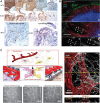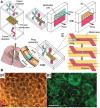Extracellular Microenvironmental Control for Organoid Assembly
- PMID: 35451330
- PMCID: PMC9836674
- DOI: 10.1089/ten.TEB.2021.0186
Extracellular Microenvironmental Control for Organoid Assembly
Abstract
Organoids, which are multicellular clusters with similar physiological functions to living organs, have gained increasing attention in bioengineering. As organoids become more advanced, methods to form complex structures continue to develop. There is evidence that the extracellular microenvironment can regulate organoid quality. The extracellular microenvironment consists of soluble bioactive molecules, extracellular matrix, and biofluid flow. However, few efforts have been made to discuss the microenvironment optimal to engineer specific organoids. Therefore, this review article examines the extent to which engineered extracellular microenvironments regulate organoid quality. First, we summarize the natural tissue and organ's unique chemical and mechanical properties, guiding researchers to design an extracellular microenvironment used for organoid engineering. Then, we summarize how the microenvironments contribute to the formation and growth of the brain, lung, intestine, liver, retinal, and kidney organoids. The approaches to forming and evaluating the resulting organoids are also discussed in detail. Impact statement Organoids, which are multicellular clusters with similar physiological function to living organs, have been gaining increasing attention in bioengineering. As organoids become more advanced, methods to form complex structures continue to develop. This review article focuses on recent efforts to engineer the extracellular microenvironment in organoid research. We summarized the natural organ's microenvironment, which informs researchers of key factors that can influence organoid formation. Then, we summarize how these microenvironmental controls significantly contribute to the formation and growth of the corresponding brain, lung, intestine, liver, retinal, and kidney organoids. The approaches to forming and evaluating the resulting organoids are discussed in detail, including extracellular matrix choice and properties, culture methods, and the evaluation of the morphology and functionality through imaging and biochemical analysis.
Keywords: biomaterials; hydrogel; microfabrication; organoid.
Conflict of interest statement
No competing financial interests exist.
Figures




References
Publication types
MeSH terms
Grants and funding
LinkOut - more resources
Full Text Sources
Research Materials

